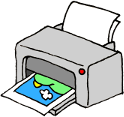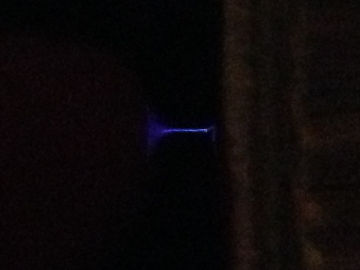Fun and easy science experiments for kids and adults.
Physics
Shrink a chip bag in the microwave oven. This is an experiment about microwaves and plastic.
| Gilla: | Dela: | |
Materials
- 1 old microwave oven
- 1 small bag of chips
Video

Warning!
In this demonstration, metal is placed in the microwave oven. This can possibly damage or shorten the lifespan of the microwave oven.Step 1


Step 2


Step 3


Step 4


Short explanation
The microwave heats the chip bag by firing microwaves at it. When the chip bag gets hot enough, the molecules it consists of curl, and the chip bag shrinks.Long explanation
The chip bag is made of long molecules called polymers. They are like long spaghettis. The natural state of these polymers is to be curled. But in the manufacturing process of the chip bag they are heated and then stretched, giving the chip bag its flat, elongated shape. By heating the polymers again with the aid of the microwave oven, they become shapable again and, since no stretching takes place, they return to their curled shape. The chip bag is covered with thin layers of things like aluminum and paint. These layers mean that the bag still somewhat retains its shape when it shrinks. A microwave oven heats food and drinks by hitting them with microwaves. Microwaves are electromagnetic waves (electromagnetic radiation) with a certain wavelength that have the ability to make molecules start moving. However, not all molecules, but only those that are polar, i.e. those that are positively charged at one end and negatively charged at one end. This polarity is due to an uneven distribution of the molecule's electrons. Polar molecules rotate in order to line up with to the microwaves. As the microwaves constantly change direction, the polar molecules continue to rotate. This heats the food, as the temperature of something is a measure of the movement of the constituent particles. Because the polar molecules collide with other nonpolar molecules in the food and set them in motion, the heat is spread. But the vast majority of molecules are to some extent polar and are thus easily heated by a microwave oven. When food is heated in a microwave oven, an energy transformation takes place. Energy transforms from electromagnetic energy to thermal energy (heat). Metal is not really suitable to place in a microwave oven. In some cases, it can even be downright dangerous. Metals contain freely moving electrons. When microwaves hit metal, the electrons on the surface of the metal begin to move back and forth very quickly. This acts as a wall for the microwaves and they are reflected instead of absorbed. If there is also pointy metal in the microwave, the electrons can be concentrated in a small area, which results in a large charge difference - voltage - compared to the surroundings. This voltage can lead to a discharge of electrons flowing to or from the surroundings. If the voltage in the metal becomes really high, the air loses its insulating ability and electrons begin to flow straight through the air. Just like lightning in a thunderstorm. If the lightning bolt reaches the walls of the microwave oven, it may burn small holes in it. It can also spread to the electronics in the microwave and destroy it. But even if no flash occurs from pointy metal, reflected microwaves from smooth metal can be absorbed by the microwave oven itself and damage it. In extreme cases it can start to burn. But small amounts of metal pose no major risk. There is some risk of damage to the microwave oven, but no risk of bodily harm.| Gilla: | Dela: | |
Similar
Latest
Content of website
© The Experiment Archive. Fun and easy science experiments for kids and adults. In biology, chemistry, physics, earth science, astronomy, technology, fire, air and water. To do in preschool, school, after school and at home. Also science fair projects and a teacher's guide.
To the top
© The Experiment Archive. Fun and easy science experiments for kids and adults. In biology, chemistry, physics, earth science, astronomy, technology, fire, air and water. To do in preschool, school, after school and at home. Also science fair projects and a teacher's guide.
To the top

































































































































